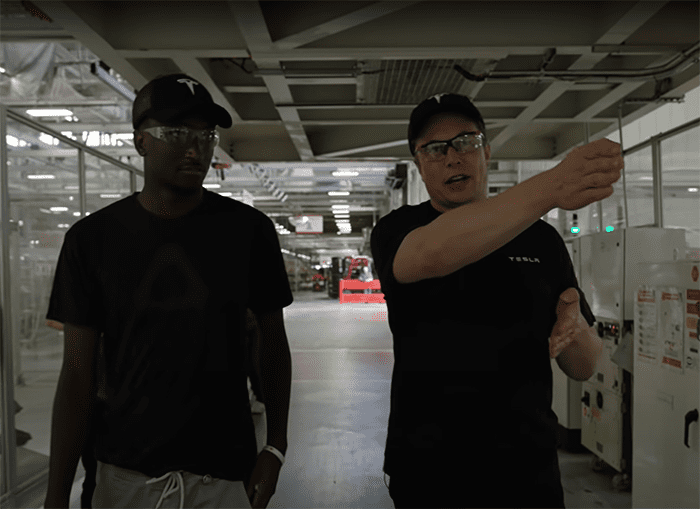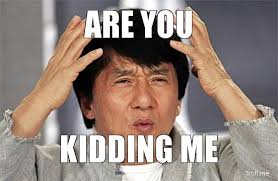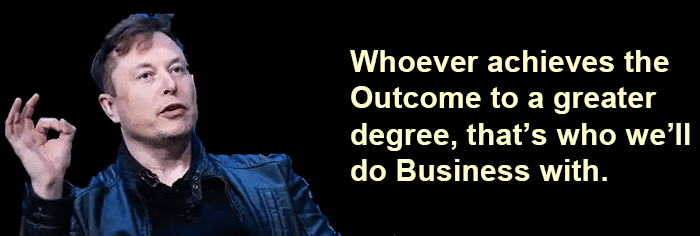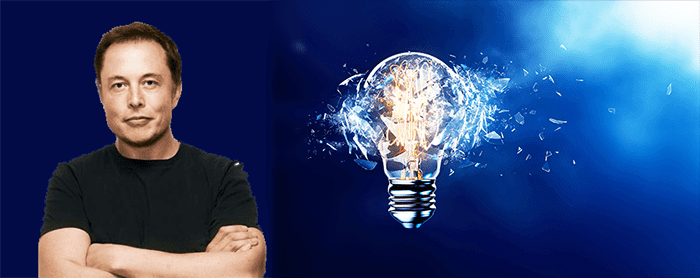Introduction
It's rare that any entrepreneur achieves the level of success Elon Musk has. And he's proven it's not just luck by succeeding over and over again. Musk is a highly intelligent and thoughtful entrepreneur. He's developed a philosophy and strategies that he uses across his entire business empire to ensure he is Winning Big in almost every case, despite taking tremendous risk along the way.
After all, who else would be crazy enough to start a private space program in this day and age?
I recently came across a wonderful interview of Elon Musk that was done for the 2020 Air Warfare Symposium. Musk was interviewed by Lt General John "JT" Thompson, who is the Commander of the Space and Missile Systems Center.
General Thompson is responsible for a $7B budget and 6000 Airmen are under his command. He's an integral part of the new US Space Force, and is keenly interested in how to operate on the cutting edge of innovation. To his credit, he had sought out Musk's advice on how to maximize his organization's success. This Symposium was designed to expose a larger audience to those insights Elon Musk had given him.
From the video, we get to share in the wealth too. As I was listening, I realized Elon Musk was giving us quite a valuable blueprint for how to succeed in Manufacturing, so I took notes and distilled his presentation down to these 7 points.
I'll present the whole video in case you want to watch, but I think it'll be even easier to follow if you allow me to walk you through the 7 points and how they apply to Manufacturing first.
1. Manufacturing is the Hardest and Most Important thing to Get Right

Elon Musk gives a tour of the Tesla Fremont factory to Marques Brownlee...
Musk makes no bones about it-Manufacturing is the hardest and most important thing to get right if you want to win.
"What I meant was that designing a production system for a product is one or two orders of magnitude harder than designing the prototype product. In recent years, we place less importance on manufacturing. That's a mistake."
"Designing a rocket is trivial. There's tons of books that will tell you exactly how to do it. Piece of cake."
"When you want to actually make one and get it to work, that is hard. Making many is extremely hard. Creating a fully optimized high volume production system is the hardest."
That should be music to the ears of many a machinist who has suffered long trying to make parts designed by engineers who don't know enough about manufacturing. And for companies that manufacture by outsourcing overseas, realize that your most difficult and important intellectual property is being developed and owned by someone else who will share it with the highest bidder.
Elon gives Starlink, SpaceX's project to bring high speed Internet to everyone via satellites, as a good example.
"Starlink is going well. It was hard to get right. We had many iterations on the prototypes."
"The production line was 1000% harder than designing the satellite. You need a tight feedback loop between design and manufacturing. In the beginning, you are building something you know is wrong in order to figure out how to build it properly."
What a fascinating and unique perspective!
Turning problems on their head to extract such perspectives is one of Elon Musk's unique strengths. He sees things differently than others. In this case, he realized that the real problem is not designing the product, it's figuring out what's hard to manufacture so the design can be improved to make manufacturing easier. Listen, if that's true for satellites, which take rocket scientists to design, it must be even more true for other products.
He had a unique strategy for tackling this problem head on:
"We brought up the Starlink production before we had the design finalized. We uncovered all kinds of things that were very difficult to make, so we changed the design."
If you've been watching the SpaceX Starship come to fruition, you'll notice he's doing the same thing. I wondered why he was building so many before even the first ones had really flown much. The answer was that he is just as interested in understanding how to manufacture them efficiently as he is in learning how to make them fly well. So, he's getting a head start in perfecting the manufacturing by learning how before finalizing the design.
Musk also realizes another important thing-you need to change the design to accommodate better manufacturing. Therefore, the design can't be finalized until you have manufacturing where you want it.
You can't learn how to manufacture well on a blackboard or computer. You've got to try to build at scale. Starting that process before the design is even finished is pretty unique, but it has been working well for Musk.
2. Innovation is the Most Important Competitive Weapon, especially against China
Fairly early in my Silicon Valley career, I found myself in the position of meeting with Bill Gates for an afternoon to talk about my Quattro Pro spreadsheet that I had developed. It was a fascinating meeting, and the biggest takeaway I had was just how deep Bill Gate's knowledge was of how all Microsoft software works internally. He was able to discuss pros and cons of spreadsheet algorithms as well as I could for the product I'd written!
Elon Musk, similarly, is a very hands on executive with deep knowledge and contribution to every aspect of the engineering that goes on for his products. He has made Innovation his chief competitive weapon and advantage.
When General Thompson asked Elon Musk how the US could stay competitive against countries like China, here's what Elon had to say:
"The thing to appreciate about China is there are a lot of smart hard working people there. They will do a lot of great things. The Chinese economy will be 2-3x as big as the US economy. That assumes GDP per capita less than US. They just have so many more people, 4-5x the population."
"As everyone here (at the Air Force Symposium) knows, the foundation of war is economics. If you have half the resources, you better be real innovative or you will lose."
"We have to use innovation to overcome a gap in economic output. Otherwise we will wind up militarily second."
The idea of using innovation to compete against a bigger competitor is a critical insight for Manufacturing too. A manufacturer that radically out innovates the competition can't help but have many advantages over that competitor. If you're the Little Guy, Innovation is your best weapon to out fight your bigger competitors.
As we're preparing the turn the corner after the Pandemic, what is your shop doing to improve its ability to Innovate?
Our next section gives Elon Musk's biggest strategy to drive innovation.
3. Use Incentives to Drive Innovation

Musk believes how you are paid is the best way to drive innovation. He favors both the carrot and the stick.
His formula is pretty simple:
- Major rewards for trying to innovate and succeeding.
- Minor consequences for trying to innovate and failing.
- Major negative consequences for not trying.
I have seen similar compensation in many Silicon Valley companies, but it tapers off the larger the company. If you have a small company trying to drive innovation, you should be thinking about how compensation can be done this way.
How do you give major rewards to your most successful innovators?
How will you penalize those who are not even trying to do better?
For Elon Musk, the penalties are no promotion followed eventually by being fired. It sounds pretty scary. When was the last time your shop fired someone for failing to be awesome? Usually people get fired because they're terrible. That's not good enough for Elon Musk's level of performance.
On the other hand, once an organization has this sort of thing baked into the culture, it will take care to hire people who know what's expected and who have a track record of being able to innovate. That makes firing much less likely.
How many manufacturers are thinking this way? Do you know any examples? Tell us in the comments!
4. Innovators have to Embrace Failure
The wreckage of SpaceX's SN8 after it crashed...
The thing about Innovation is it involves risk. The greater the rewards you seek, the higher the risk in most cases.
That risk makes a lot of people, especially middle management and business owners who've reached a certain stage, fear Innovation. If you let fear of failure get out of hand, you will not only stop innovation, but you may even go backwards.
So, Musk's answer is to learn to accept failure. Recognize that you can learn a lot from failures. Therefore, you must give people permission to fail.
Musk likens it to baseball:
"In baseball you can't wait for an easy pitch. After 3 you're out."
"So the real question is what's your batting average."
"There will be some amount of failure, but if your net useful output is maximized, you win."
"Failure is irrelevant unless it is catastrophic."
A catastrophic failure is one that destroys or seriously cripples the business.
Let's put this into manufacturing terms with a simple example:
When was the last time you cranked up your feeds and speeds and kept going faster until you broke an endmill? Does it scare you to break tools like that? Are you overly penalized for that tool breakage or rewarded because you found the fastest a job could be run?
Alternatively, if your experiments in innovation cause bodily harm, liability, or damage a machine so it's out of action and expensive to fix, that may be too much. That might be a catastrophic failure for your business that should've been avoided.
5. You Push to Sell innovation, Pull to Refine

In this segment, the general is talking about PUSH versus PULL to define a product. With push you're creating something completely new. Something that shouldn't really be looked at as an incremental change, but rather a whole new approach with radical advantages.
"PULL" product definition is more incremental. For example, refining your product by listening to customer feedback.
Steve Jobs was the master of PUSH, and consequently didn't care an awful lot about PULL. PUSH products are called "visionary" in the Silicon Valley world.
Elon Musk tells this interesting story to get the point across:
"In the beginning nobody wanted a Tesla, I can tell you that!"
Customers: "Why would I want that? I like my gasoline car."
Elon: "No it's better, you should try it."
"Nobody told us they wanted an electric car. I heard that zero times."
"You can't make incremental improvements to horses to innovate cars."
"When they first made TV's, there was a nationwide survey where 96% of respondents said they'd never buy a TV. "
If you sell products, I leave it to you to apply this to your marketing. But how does this apply to Manufacturing?
Selling is endless. In some ways, everything we do involves a sale if we have to convince others to do what we want. Within a manufacturing operation, if you're trying to Innovate, you're probably going to be pushing some ideas that are not just incremental refinements of what's already being done. For those cases, you've got to be able to sell "PUSH" style.
I talked to a G-Wizard Calculator customer recently. He was the son-in-law of the Job Shop's owner, and wanted to introduce G-Wizard Calculator for their feeds and speeds.
His initial attempts were met with a lot of skepticism and doubt. The shop had their own ideas about Feeds and Speeds, which were largely just extensions of what the machinists had used on their manual machines. CNC's are capable of a lot more, if only because you can't turn the handwheels fast enough to keep up with a CNC's feed rates.
After getting too much initial pushback, he came to me for help. He wanted to try some feeds and speeds, and he wanted me to make sure he had them right so he wouldn't fail when attempting to show everyone that they worked.
I was happy to review them for him, and also to give him some thoughts on how to present it in a low risk / high reward way. I told him to set up a cut on some scrap material, to tell the boss exactly what he was doing and how much faster the feeds and speeds would be.
When the boss inevitably told him it was impossible, I suggested he offer to pay for the endmill if he broke it in the demonstration. It was a small concession, but it made it that much easier for the Boss to allow the demonstration.
Sure enough it worked like a champ. The cut was done MUCH faster than what they'd been using. The Boss proclaimed it had dulled the cutter, but he stuck to his guns, pulled the end mill out of the collet chuck, ran his finger along the edge to make sure, then passed it around saying, "That end mill is just as sharp as a new one, see for yourselves."
They gradually started working the new feeds and speeds into new jobs, and sure enough it was a very profitable change for them.
The point is, you need to be aware when you're introducing radical change that you have to address the objections, minimize the risks, and get them to allow it even if only through curiousity. At the same time, Make Darned Sure the Test Succeeds Brilliantly!
Teslas doesn't just sell Electric Cars. They sell cars with amazing performance. They needed to show big advantages to get their idea across, and they did.
6. Use Outcome based procurement when outsourcing

Outsourcing is a fact of life for Manufacturers. Either we are the Job Shop outsourced to manufacture, we're competing against outsourcing, or we're outsourcing processes and components from our shop that it doesn't make sense for us to do.
Elon Musk's approach to optimizing outsourcing is to focus on the outcome. He derives the important metrics for an outcome and then chooses the Outsourcer who gives him the best outcome as measured by those metrics. The metrics might be cost, quality, or whatever else he thinks will maximize his chance for success.
That sounds obvious, but too often Outsourcers are chosen via the "Old Boy" network. Who are we friends with? Who do we already know? Musk wants to discount those factors in his quest for ever greater performance.
When you are competing, think about whether you can sell Outcome more successfully than your competitors. That could be your way into some new contracts.
7. The Best Way to Protect IP is to Keep Creating Innovative New IP

If your primary competitive weapon is going to be Innovation, how do you protect your Intellectual Property?
This is always a challenge. Many will be drawn to the idea of patents, and they can work, but often they're expensive and not very good protection. If you don't have the money to pursue a patent case in court, what good is having a patent? It can take $1 million in legal fees just to get to the first day of trial in the worst case.
That's why Patent Trolls have such a lucrative business in the US. They take patents that are likely to be tossed out in court and demand payments less than the cost of getting them thrown out in court. Nasty business.
I have always felt that the best way to defend your Intellectual Property is to innovate faster than the competition can copy your innovations. That way they are at a severe disadvantage because you control the game-they're investing everything they can just chasing you and trying to keep up.
We certainly have competitors, but we have introduced most of the new developments in our space, and they've struggled to keep up.
Here's what Elon Musk has to say:
"The real way to achieve IP protection is to innovate fast enough. If you innovate fast enough, you don't have to protect IP. The others will be copying things you have moved on from.
Speed of innovation matters."
It's important to differentiate the Pace of Innovation from the individual Innovations:
"Innovation per year is what matters. It isn't that you made a 100% improvement. It's how long did it take? 100 years, not impressive. 1 year? 6 months? Yes.
You need to try to accelerate your rate of innovation."
How do you accelerate your rate of innovation?
Start by making it a focus. Make sure every employee knows this is how you want to compete and that it is important. Follow the other strategies I've mentioned above and you will have that innovation.
Conclusion
There you have it. A roadmap for how to implement Elon Musk-style Manufacturing. It's pretty different from how most of the world operates. But then Elon Musk is getting pretty different (and amazing) results from the rest of the world.
Here's the whole video, as promised:
Be the first to know about updates at CNC Cookbook
Join our newsletter to get updates on what's next at CNC Cookbook.
